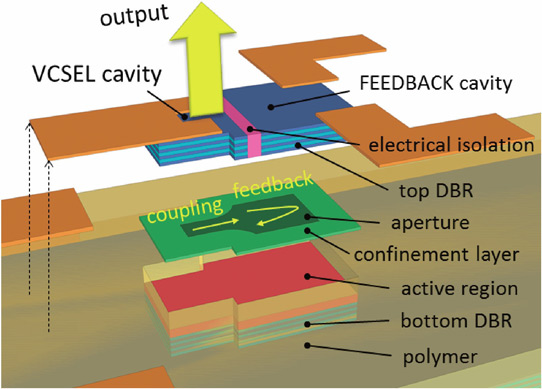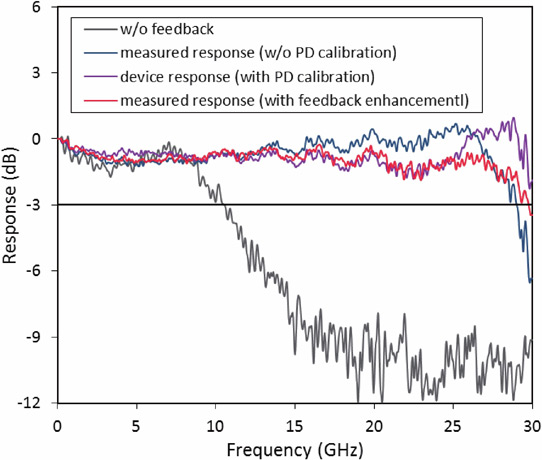- News
12 August 2015
Transverse-coupled-cavity VCSEL with 30GHz bandwidth at 850nm
Researchers at Tokyo Institute of Technology in Japan and King Abdulaziz University in Saudi Arabia claim record modulation bandwidth of 30GHz from an 850nm vertical-cavity surface-emitting laser (VCSEL) with monolithic integration of a transverse-coupled cavity [Xiaodong Gu et al, Appl. Phys. Express, vol8, p082702, 2015].
The researchers comment: "The proposed device also shows its great advantage in operating with ultra-low power consumption because of its small bias current and low voltage swing of 500mVpp. It is especially important for use in data-centers and supercomputers, where 850nm VCSELs are the core component with a huge volume."

Figure 1: Schematic view of 850nm-band transverse-cavity surface-emitting laser.
The 850nm VCSEL epitaxial material was grown using metal-organic chemical vapor deposition (MOCVD). The VCSEL and cavity (Figure 1) were formed as a paddle-shaped mesa, described as 'battledore-shaped' in the paper. [I was rather unfamiliar with the term 'battledore', but an internet search turned up https://en.wikipedia.org/wiki/Battledore_and_shuttlecock and, perhaps more relevant given the Japanese origin of most of the authors, https://en.wikipedia.org/wiki/Hanetsuki.]
Electrical isolation between the VCSEL and cavity was achieved by a proton implant of a 3μm- or 5μm-wide region through the top distributed Bragg reflector (DBR). Wet oxidation formed the current aperture, which was also 'battledore-shaped'. The VCSEL area of 10μmx14μm was connected with the 20μmx24μm cavity. The oxidation distance was 5μm from the sidewall. The tapered aperture width change between the cavity and VCSEL aimed to enhance lateral coupling of the optical modes. These small dimensions suggest the practicality of high-density integration.
The researchers explain: "The reason is that the cutoff wavelength of the VCSEL side will be red-shifted by the heat, which keeps the light from coupling to the feedback cavity. The length of the feedback cavity is critical for selecting a suitable mode for bandwidth enhancement."
The modulation of the VCSEL was through a direct 40GHz radio frequency probe attached to the ground-signal-ground electrodes.
The researchers claim a record 3dB bandwidth of more than 30GHz with 4.3mA injected into the VCSEL with 5μm-wide proton implant for electrical isolation (Figure 2). The bandwidth was also 3x that for a device without feedback. By injecting 0.3mA into the cavity to enhance the feedback, the bandwidth was 30GHz, even without calibrating the measuring photodetector's response.

Figure 2: Small-signal frequency responses of the device for different cases. Feedback is enhanced by injecting a 0.3mA current to the feedback cavity.
The researchers write: "This means that an enhancement in the response at high frequency compensates well for the drop in detector response. This optical equalization ability demonstrates our device's dynamic adjustability, which enables it to perform in the best condition for a given system."
In addition, recent modeling by the researchers suggests that an even higher bandwidth of more than 50GHz could be obtained by increasing the coupling strength.
At the non-standard 980nm wavelength band, a bandwidth of more than 29GHz has been achieved with a transverse-coupled-cavity VCSEL and 37GHz with single-mode coherent twin VCSELs with resonance tuning. Apart from the non-standard wavelength, these devices required precise fabrication processes, making uniform performance difficult to achieve in mass production.
Eye-diagrams produced in large-signal modulation on the team's 850nm VCSELs with non-return-to-zero pseudo-binary sequences with 500mV peak-to-peak swing were 'open' from 30Gb/s up to 40Gb/s, indicating acceptable performance. At the higher bit-rates, some noise was seen that prevented clear opening of the diagrams. The researchers comment: "We think part of the noise came from the unstable mode, resulting in fluctuations of the light collected in a multi-mode fiber. Better mode stabilization is necessary for clear eye opening at higher bit-rates."
The researchers believe that stabilizing the coupled mode will lead to higher bit-rate modulation. The IBM Thomas J. Watson Research Center has recently achieved 71Gb/s error-free operation for an 850nm VCSEL-based optical link.
http://dx.doi.org/10.7567/APEX.8.082702
The author Mike Cooke is a freelance technology journalist who has worked in the semiconductor and advanced technology sectors since 1997.


